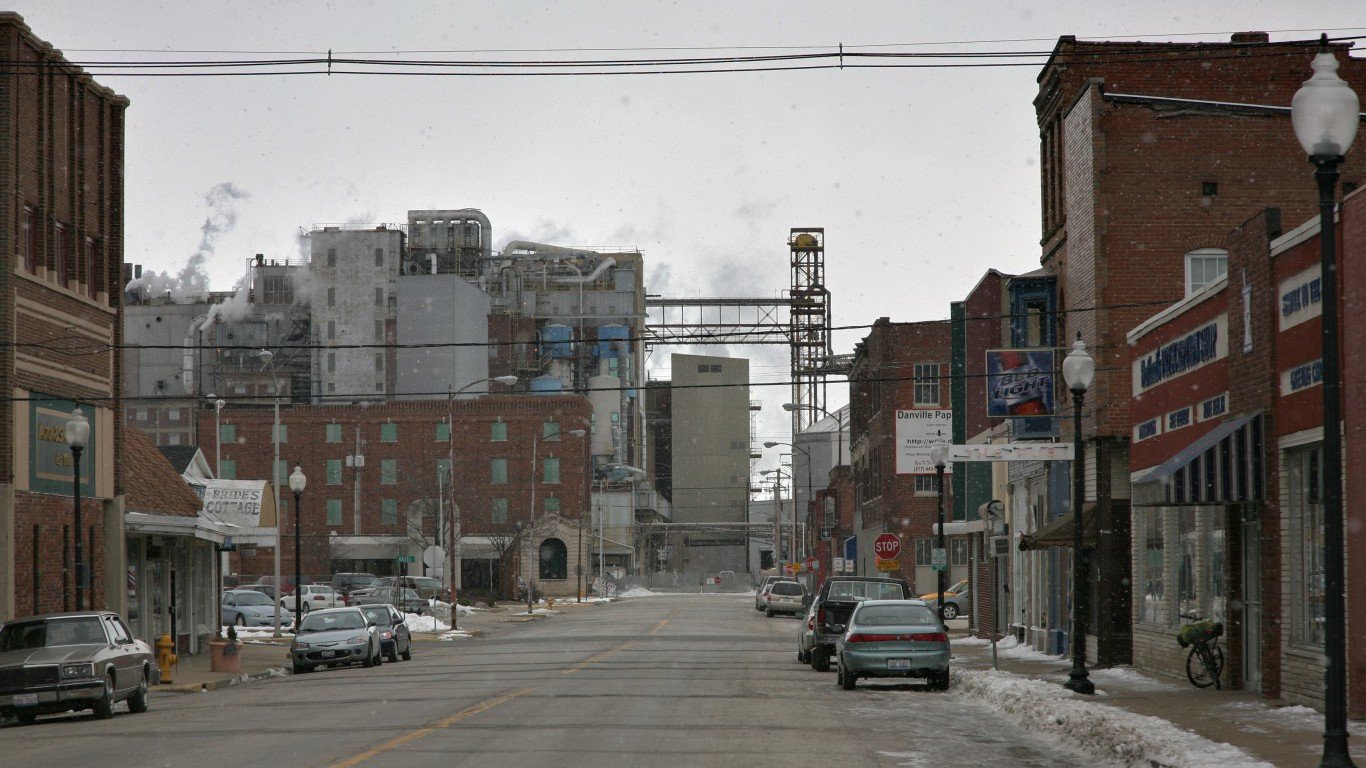Special Report
10 Cities Where Incomes Are Shrinking the Fastest

Published:
Last Updated:

Personal income grew by 4.1% across the nation in 2015. The vast majority of metropolitan areas contributed to this growth, but in 10 urban regions, incomes declined. Personal income, which tracks all income received by all persons in an area, generally reflects how well an economy is doing.
[in-text-ad]
Based on recently released data from the Bureau of Economic Analysis (BEA), 24/7 Wall St. reviewed the metropolitan statistical areas with the largest personal income growth rates, and the ones with the greatest declines.
Growth rates were calculated based on total real personal income — which includes compensation, income from property and from owning a business, minus contributions to the government — for all people in each metro area. Since growth rates were based on aggregate incomes, an increase in a city’s population was often a major driver of growth.
Many of the metro areas where incomes declined have struggled due to their dependence on the floundering extraction industries. Many of the cities where incomes are growing the fastest, by contrast, have budding technology industries.
Click here to see the 10 cities where incomes are shrinking.
Click here to see the 10 cities where incomes are growing.
Click here to see our detailed findings and methodology.
Cities Where Incomes are Shrinking the Fastest

10. Beckley, WV
> Income growth in 2015: -0.1%
> Income growth 2010-2015: -2.3%
> Per capita income: $38,595
> May unemployment rate: 5.0%
A decline of one-tenth of one percent may not seem remarkable, but Beckley is one of only 10 U.S. metro areas where personal income declined in 2015. The decline is smaller than it was in 2014, however, when total incomes earned in the metro area dropped by 2.3%.
Like a number of the other metro areas with declining incomes, the share of Beckley’s labor force employed in the mining industry, at 4.2%, is one of the highest shares compared with other metro areas. Just over 1% of the U.S. labor force is employed in natural resources and mining. Beckley, like West Virginia and much of the Appalachian region, has struggled to maintain economic growth amid falling demand and investment in coal.
[in-text-ad]

9. Danville, IL
> Income growth in 2015: -0.4%
> Income growth 2010-2015: -2.6%
> Per capita income: $40,241
> May unemployment rate: 6.7%
Once home to manufacturing facilities of major corporations, including General Electric and General Motors, Danville’s economy was decimated as they each shuttered their factories over the last few decades. According to a recent Brookings Institution analysis, between 1980 and 2005, the number of manufacturing jobs in the Danville metro area fell by nearly half, driving a 12.4% decrease in the total number of jobs.
The area’s economy is still suffering today, which likely helps explain the metro area’s declining population. With a 6.7% unemployment rate, well above the 4.4% U.S. rate, Danville’s population fell by roughly 1% in each of the last two years.

8. Longview, TX
> Income growth in 2015: -0.8%
> Income growth 2010-2015: 7.1%
> Per capita income: $42,153
> May unemployment rate: 5.8%
Longview, Texas is one of only 10 U.S. metro areas to report a decline in personal income in 2015. Declines in economic output in several major sectors in the metro area, including durable goods manufacturing, trade, transportation and utilities, contributed to a 2.3% overall decline in GDP in 2015, one of the steeper economic contractions among U.S. metro areas.
Declines in economic output and income have ultimately worsened the financial situation of many Longview area residents. The share of metro area residents living in poverty climbed from 16.2% in 2014 to 16.6%, even as the U.S. poverty rate fell from 15.5% to 14.7% over the same period.

7. Houma-Thibodaux, LA
> Income growth in 2015: -1.0%
> Income growth 2010-2015: 7.3%
> Per capita income: $45,514
> May unemployment rate: 6.3%
Personal income is closely tied to total economic output, and in 2015, Houma-Thibodaux’s GDP fell by 7.8%, the second steepest drop among metro areas in the United States.
The area’s economic slowdown is largely the consequence of falling oil prices. The oil bust that began in 2014 had an outsized impact on transportation and utilities, the largest sector by employment in the metro area. The sector, which includes natural gas distribution and power generation, was the largest drag on GDP in the metro area in 2015.
[in-text-ad-2]

6. Tulsa, OK
> Income growth in 2015: -1.3%
> Income growth 2010-2015: 41.6%
> Per capita income: $58,164
> May unemployment rate: 4.8%
Despite a 1.1% population growth rate in 2015, which was faster than the national average pace of 0.7%, total income across the Tulsa metro area fell by 1.3% that year. The drop in income is a departure from the area’s longer-term trend. The Tulsa area reported a 41.6% increase in personal income from 2010 to 2015, the third largest of any U.S. metro area.
The area’s falling incomes are likely tied to the declines in major industries in Tulsa. A disproportionately large share of workers in the metro area are employed in the trade, transportation, and utilities and the manufacturing sectors. Both sectors, which together make up Tulsa’s economic backbone, were a drag on economic output in 2015.

5. Enid, OK
> Income growth in 2015: -1.7%
> Income growth 2010-2015: 0.0%
> Per capita income: $45,838
> May unemployment rate: 3.9%
Shrinking personal income is usually reflective of a struggling economy overall. In Enid, however, the May unemployment rate of 3.9% was lower than the national rate and unusually low compared with other metro areas with shrinking incomes. As is generally the case among these cities with shrinking incomes, however, Enid’s per capita income of $45,838 remains higher than the national income level.
The 2015 income decline may not be a major cause for concern. According to the Enid Regional Development Alliance, the area is particularly amenable to agricultural businesses. Consolidated Grain and Barge, one of the region’s largest grain shippers, is located in the metro area.
[in-text-ad]

4. Lafayette, LA
> Income growth in 2015: -2.0%
> Income growth 2010-2015: 9.0%
> Per capita income: $44,550
> May unemployment rate: 6.3%
Personal income dipped considerably in the Lafayette metro area in 2015. That year, total income in the area fell by 2.0% — only one year after climbing 4.6%. Falling incomes in the metro area coincided with worsening economic conditions for a considerable share of the population. The metro area’s poverty rate jumped from 16.3% in 2014 to 19.0% in 2015 — even as the poverty rate declined nationwide.
Lafayette is yet another metro area on this list depending heavily on energy-related sectors. A combined 29.2% of the metro area’s labor force work in the natural resource and mining and trade, transportation, and utilities sectors. Incomes in the area likely fell as these sectors’ output faltered.

3. Casper, WY
> Income growth in 2015: -3.2%
> Income growth 2010-2015: 38.0%
> Per capita income: $64,223
> May unemployment rate: 5.5%
The 3.2% decline in personal income in the Casper metro area marks a break from a longer-term trend. Between 2010 and 2015, incomes in the metro area soared 38.0%, more than in all but four other U.S. metro areas. In 2014 alone, incomes in Casper climbed by a nation-leading 12.0%.
Like many other cities on this list, Casper is heavily dependent on its oil and natural gas industry, and falling oil prices have hurt the metro area’s economy in recent years. Declining economic output in the energy sector likely caused a ripple effect, as the construction, trade, and transportation and utilities sectors were each a drag on economic growth in 2015.

2. Odessa, TX
> Income growth in 2015: -6.5%
> Income growth 2010-2015: 34.1%
> Per capita income: $43,070
> May unemployment rate: 4.8%
Like Midland, Odessa has experienced erratic economic shifts in recent years due to falling demand for fossil fuels and the recent dramatic drops in oil prices. So while in 2014 income earned in the area was up by 8.9%, and between 2010 and 2015 income was up by 34.1% — each among the fastest growths nationwide — incomes fell by 6.5% in 2015.
Unlike neighboring Midland, which reported unusually high GDP growth despite falling incomes, Odessa’s economy contracted sharply in 2015. The metro area’s natural resources and mining industry accounted for 1.3 percentage points of the near nation-leading 7.3% GDP decline. The industry employs 11.7% of Odessa’s labor force, versus the average share of workers employed nationwide in the sector of just 1.3%.
[in-text-ad-2]

1. Midland, TX
> Income growth in 2015: -10.1%
> Income growth 2010-2015: 53.4%
> Per capita income: $95,616
> May unemployment rate: 3.5%
Despite reporting the strongest GDP growth of any metro area in 2015, personal incomes in Midland, Texas fell by 10.1% in 2015, by far the steepest such decline in the United States. The recent decline in personal income in the area marks a break from the longer-term trend. Between 2010 and 2015, personal income in Midland climbed 53.4%, the strongest increase of any U.S. metro area thanks to a booming oil business.
As crude oil prices tanked in 2014, however, oil-rich Midland began to feel the effect, and 2015 marked a downturn for the once booming town.
Cities Where Incomes are Growing the Fastest

10. Stockton-Lodi, CA
> Income growth in 2015: 7.8%
> Income growth 2010-2015: 18.9%
> Per capita income: $35,421
> May unemployment rate: 7.0%
The Stockton-Lodi metro area’s population grew by 1.4% in 2015, double the U.S. population growth rate that year. With additional income-earners, aggregate personal income in the area also grew in 2015 at nearly double the U.S. rate, at 7.8% versus 4.1%.
Natural resource extraction and mining contributed to overall GDP growth in the metro area more than any other industry. Though the largest contributor to economic growth is not an especially high paying industry, it employs 6.9% of the Stockton-Lodi workforce. In comparison, natural resource extraction and mining accounts for only 1.3% of all jobs nationwide.
[in-text-ad]

9. Vallejo-Fairfield, CA
> Income growth in 2015: 7.9%
> Income growth 2010-2015: 17.7%
> Per capita income: $35,227
> May unemployment rate: 4.8%
The Vallejo-Fairfield metro area’s population grew by 1.1% in 2015, well above the U.S. population growth over the same period. A growing population adds incomes to the economy, and generally reflects strong consumer confidence. Incomes grew by 7.9% in the metro area in 2015, also nearly double the U.S. income growth.
Income growth in Vallejo-Fairfield coincided with improved economic conditions. The metro area’s poverty rate fell slightly from 12.3% in 2014 to 12.1% in 2015. Some of the income gains occurred at the top of the income spectrum. The share of area households earning over $200,000 a year climbed from 5.2% to 5.6% over the same period.

8. Reno, NV
> Income growth in 2015: 7.9%
> Income growth 2010-2015: 12.3%
> Per capita income: $44,005
> May unemployment rate: 4.1%
Reno’s durable goods manufacturing industry contributed 0.7 percentage points to the area’s above-average 2015 economic growth of 3.3%. The contribution may seem small at under 1 percentage point, but it is seven times greater than the national average contribution of the industry. Reno has enjoyed something of a tech boom in recent years, and the industry’s growth is likely in part the result of companies like Apple, Google, and Tesla expanding operations in the region. Each of these tech giants now has facilities operational or under construction in Reno. The area’s rapid tech expansion has so far likely led to the area’s income growth. A review of local news reports reveals wide approval of the growth, but there are also concerns that with rising demand for high-end apartment buildings an affordable housing shortage may also emerge.

7. Nashville-Davidson–Murfreesboro–Franklin, TN
> Income growth in 2015: 8.0%
> Income growth 2010-2015: 23.6%
> Per capita income: $49,465
> May unemployment rate: 2.6%
The Nashville metro area’s 8.0% growth in income in 2015 is due in part to the area’s 2.0% population growth, which was more than double the 0.7% U.S. population growth.
The metro area’s thriving professional and business services industry also likely played a role in the metro area’s near nation leading income growth. The industry contributed far more than any other to Nashville’s 3.9% GDP growth in 2015. The metro area’s largest industry by total employment, professional and business services, is also high paying. The average annual salary in Nashville’s professional business services industry is $65,539, well above the area’s $49,465 per capita income.
[in-text-ad-2]

6. Kennewick-Richland, WA
> Income growth in 2015: 8.2%
> Income growth 2010-2015: 7.5%
> Per capita income: $37,939
> May unemployment rate: 5.6%
Incomes in the Kennewick-Richland metro area climbed by 8.2% in 2015. Over the same time period, the area’s poverty rate fell from 16.3% to 15.5%.
The professional and business services sector is the largest industry in the metro area by total employment, as well as the second highest paying. The industry employs 18.1% of the area labor force, 12th highest compared with the industry’s employment levels in other U.S. metro areas. The average salary among professional and business service workers in the state is $83,276 a year, more than double the per capita income across the metro area. Two of the largest employers in the area are the Department of Energy’s Pacific Northwest National Laboratory and construction and engineering company Bechtel.

5. Bend-Redmond, OR
> Income growth in 2015: 8.5%
> Income growth 2010-2015: 33.8%
> Per capita income: $42,084
> May unemployment rate: 3.6%
Personal income growth in the Bend-Redmond metro area in 2015 is part of a longer-term trend. Income in the area climbed by 33.8% since 2010, clocking an 8.5% growth in 2015 alone. Major employers that have either popped up in the metro area or expanded within the last few years include Epic Aircraft, an experimental aircraft designer and manufacturer, business solutions company BASX, and a Facebook Data Center. Combined, these organizations alone have created hundreds of jobs within the last few years. Not surprisingly, both the professional and business services and information sectors drove GDP growth in the metro area in 2015.
[in-text-ad]

4. Sioux Falls, SD
> Income growth in 2015: 8.6%
> Income growth 2010-2015: 20.7%
> Per capita income: $53,360
> May unemployment rate: 2.5%
The 8.6% income growth in the Sioux Falls metro area in 2015 appears to have disproportionately benefited the wealthy. From 2014 to 2015, the metro area’s poverty rate climbed from 9.7% to 11.5%. Over the same period, the share of households earning $200,000 or more a year also increased from 3.6% to 4.1%.
Income growth was likely driven in large part by considerable growth in the finance and real estate sector — a generally high-paying industry — as well as the education and healthcare and constructions sectors, which are industries that tend to thrive with population growth. The Sioux Falls population grew by 1.6% in 2015, more than double the comparable U.S. population growth.

3. Yuma, AZ
> Income growth in 2015: 8.7%
> Income growth 2010-2015: 13.8%
> Per capita income: $31,190
> May unemployment rate: 17.2%
Fast growing personal income in an area does not necessarily mean incomes are high, or even that the economy is doing especially well. In fact, several of the cities with the fastest-growing incomes are among the poorest regions in the country. Yuma is one such area. Even after near nation-leading income growth in 2015, the metro area’s per capita income of $31,190 is the seventh lowest income level nationwide.
Incomes earned in Yuma grew by 13.8% between 2010 and 2015, lower than the national average growth of 15.2%. In 2014, total income fell by 0.5%, making Yuma the only city on this list where incomes declined in 2014.

2. Sebring, FL
> Income growth in 2015: 9.1%
> Income growth 2010-2015: 9.9%
> Per capita income: $35,790
> May unemployment rate: 5.9%
Nearly all recent earnings and workforce growth in the Sebring metro area occurred in 2015, as personal income remained relatively flat between 2010 and 2014. Although incomes in Sebring grew considerably in 2015, the Sebring metro area per capita income of $35,790 annually remains much lower than in the vast majority of metro areas. Sebring’s mining sector was a primary contributor to the area’s GDP growth of 3.4% in 2015, which was well above the national average GDP growth that year of 2.5%. Approximately 8.8% of the area’s workforce is employed in natural resources and mining occupations, versus the national average percentage of 1.3%.
Sebring residents do not have high incomes. More than 10% households in Sebring have incomes of $10,000 or less, versus the national average percentage of 6.9%. The typical home value is $92,600, nearly the lowest in the nation but also a possible explanation for the area’s exceptionally high homeownership rate of 75%.
[in-text-ad-2]

1. Carson City, NV
> Income growth in 2015: 9.9%
> Income growth 2010-2015: -0.8%
> Per capita income: $41,804
> May unemployment rate: 5.0%
Carson City residents earned nearly $2.3 billion in 2015, a 9.9% increase from 2014. The area’s income growth rate was more than double the national growth and the largest of all U.S. metro areas. Unlike other cities on this list, the strong one-year income growth was not enough to offset the income decline between 2010 and 2015. Population growth, which usually results in added income was not a significant factor in Carson City’s income growth. This means that area workers likely received raises. At the same time, the strong income growth can be partially attributed to the fact that Carson City has a small population. At 54,742 people, it is the smallest of all U.S. metro areas, and with so few residents, small changes can appear relatively large.
According to the Carson City Chamber of Commerce, the area is a hub for Nevada’s manufacturing operations. Most of the area’s manufacturers are based in the Airport Industrial Park, and the top manufacturing industries include electronics, transportation, and machinery.
The U.S. population grew by 0.7% in 2016, in line with the 2015 growth rate. In nine of the cities where incomes declined, population growth last year trailed the national growth. Six of these cities reported population declines. In all but one of the 10 metro areas with rising incomes, on the other hand, population growth outpaced the nation’s.
Income growth is also strongly associated with economic expansion. Often, activity within a particular industry accounted for the bulk of the changes in total income generated in the area. The economies of all but three of the top 10 metro areas for income growth expanded faster than the nation’s 2015 GDP growth of 2.5%. With the exception of Midland, Texas, the opposite was true in the 10 metro areas with the fastest declining incomes.
The industries that contributed most to changes in GDP varied considerably. The durable goods manufacturing industry was a drag on economic growth in nine of the 10 cities with shrinking incomes. Data was not available for the one exception. Natural resources and mining industries had relatively strong contributions to economic growth in three of the 10 metro areas, but GDP growth overall was below the national growth rate in these cases. The sector was a drag in two of the 10 cities with declining incomes.
To be sure, strong income growth is a good sign of the financial health of an area’s residents, just as a decline in personal income is generally a bad sign. However, strong income growth
in an area does not necessarily mean incomes are very high, and income declines are actually relatively common in areas with high incomes. Per capita income in 2015 exceeded the national income figure of $43,925 in only three of the 10 cities with the fastest growing incomes. By contrast, income per capita was higher than average in six of the 10 cities with shrinking incomes.
Most of these income declines are relatively recent. Only two of the metro areas reported personal income declines between 2010 and 2015. Income growth over that period in four of the 10 cities actually remains among the top 10 in the nation. On the other hand, in the cities where incomes grew fastest in 2015 the growth was generally reflective of consistent income growth over a longer period.
To identify the cities where incomes are growing (and shrinking) the fastest, 24/7 Wall St. reviewed the highest and lowest real personal income growth rates in 2015 among the nation’s 381 metropolitan statistical areas from the Bureau of Economic Analysis. Real personal income, per capita income, GDP, and industry contributions to GDP growth in each MSA also came from the BEA. The BEA’s income figures for each year starting in 2010 were reviewed as well, all adjusted for inflation, chained to 2009 dollars. The share of each MSA’s workforce employed in each area’s industry in 2014 and 2015, as well as average wages by industry for each MSA, came from the Quarterly Census of Employment and Wages, a program of the Bureau of Labor Statistics. Population growth, median household income, poverty rates, the percentage of households earning at least $200,000 and less than $10,000, and educational attainment rates also came from the American Community Survey. May unemployment rates came from the U.S. Bureau of Labor Statistics.
Ever wanted an extra set of eyes on an investment you’re considering? Now you can speak with up to 3 financial experts in your area for FREE. By simply
clicking here you can begin to match with financial professionals who can help guide you through the financial decisions you’re making. And the best part? The first conversation with them is free.
Click here to match with up to 3 financial pros who would be excited to help you make financial decisions.
Thank you for reading! Have some feedback for us?
Contact the 24/7 Wall St. editorial team.